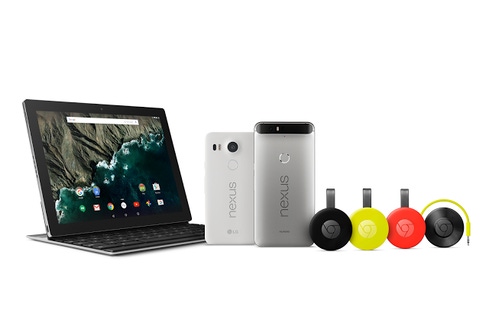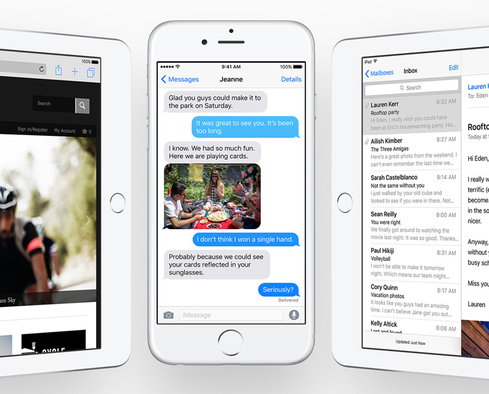Android 6.0 will be making an appearance on two new Nexus phones and a Pixel tablet.


iOS 9: 10 More Hidden Features To Explore
iOS 9: 10 More Hidden Features To Explore (Click image for larger view and slideshow.)
At a media event in San Francisco on Tuesday, Google announced two Nexus phones, Android 6.0 Marshmallow, its Pixel C Android tablet, and two Chromecast devices, one for video and the other for audio.
Sundar Pichai, in his first Google event as CEO, started the presentation with an update on Android's progress. A year ago, he said, there were more than a billion 30-day-active Android devices. Today, he said, there are more than 1.4 billion.
"In most of these cases, these are people who are adopting a smartphone for the first time," said Pichai.
The Nexus 5X, made by LG, runs on a Snapdragon 808 processor (1.8 GHz hexa-core 64-bit). It includes a 5.2-inch FHD LCD (1920 x 1080) screen and a USB 3.0 Type-C port, which has the virtue of accepting compatible cords in any orientation. It comes with 2GB of RAM, a 12.3-megapixel rear-facing camera, a 5-mexapixel front-facing camera, a fingerprint sensor called Nexus Imprint, and a 2700mAh battery. The phone is available in charcoal black, quartz white, and ice blue.
The 16GB Nexus 5X lists for $379 and the 32GB model lists for $429.
[How will we connect tomorrow? Read 8 Smart Cities: A Peek at Our Connected Future.]
The Nexus 6P, made by Huawei, relies on a Qualcomm Snapdragon 810 v2.1 processor (2.0 GHz octa-core 64-bit). It comes with a 5.7-inch AMOLED (2560 x 1440) screen and a USB 3.0 Type-C port. It had 3GB of RAM, a 12.3-megapixel rear-facing camera, an 8-megapixel front-facing camera, a rear-mounted Nexus Imprint fingerprint sensor, and two front-facing speakers.
The Nexus 6P is available in aluminum, graphite, and frost with 32GB, 64GB, or 128GB of storage, priced at $499, $549, and $649 respectively.
Both phones can be pre-ordered today and are expected to ship soon.
LG and Huawei have a tough act to follow. Apple said on Monday it had sold more than 13 million iPhone 6 and 6S models over the previous three days, a record for the company.
Google's Pixel line began as a touch-enabled Chrome OS notebook in 2013, with an updated version released earlier this year. Unlike Nexus devices, which identify a hardware partner, Pixel devices carry the Google brand. To date, they've served as luxury proof-of-concept devices, rather than products intended for mass distribution.
The goal of the Pixel team, said Pichai, "has been to build aspirational devices, so they can guide the ecosystem into new areas."
The Pixel C -- "C" stands for "convertible" -- is an Android-powered tablet with a 10.2-inch (2560 × 1800) screen and a detachable keyboard. It's Google's answer to Microsoft Surface. It relies on an NVIDIA X1 quad-core processor, a Maxwell GPU, and 3GB of RAM. Like other devices introduced at the event, it includes a USB 3.0 Type-C port.
Available toward the end of the year, the 32GB Pixel C will cost $499 and the 64GB model will cost $599. The keyboard will be available for $149.
Google redesigned its Chromecast streaming video device with a more flexible form factor, making it easier to connect in tight spaces. It features faster WiFi, a smarter antenna, and an improved app for Android and iOS. The updated Chromecast comes in three colors (black, lemonade, and coral) and is available today in 17 countries. The price remains $35.
According to Mario Querioz, VP of product management at Google, more than 20 million Chromecast devices have been sold since mid-2013. As a point of comparison, Apple CEO Tim Cook said in January that Apple had sold 25 million Apple TV devices. But Chromecast's affordability may help Google catch up. The latest Apple TV starts at $149.
Google expanded its Chromecast line with Chromecast Audio, a $35 wireless receiver to connect speakers and stereo systems to music on other devices, and via streaming services like Google Play Music, Pandora, and Spotify.
Android 6.0 Marshmallow, available next week as an OTA update to Nexus devices, brings a handful of significant changes to the Android ecosystem. The app permission system has been streamlined to request permission when necessary, rather than when an app is launched. Fingerprint reader support has been standardized, allowing developers to add fingerprint authentication to their own apps. Chrome Custom Tabs allow customizable Chrome windows to be opened atop an active app. They allow a better user experience than shifting to the separate Chrome app.
The update also integrates Android Pay to provide fingerprint-enabled mobile payments. It also brings charging and battery management improvements (such as Doze mode), and navigation refinements that allow URLs to take visitors to the publisher's app, instead of asking how to handle the link.
Google Now, the company's real-time assistance service, has been enhanced to make inferences about queries more effectively. It is now available in about 100 other apps under the name "Now on Tap."
Another particularly compelling Marshmallow feature is Auto Backup for Apps, which periodically backs up the data and settings associated with apps to the user's Google Drive account. The files must be 25MB or less, but it works even for apps that were not installed through Google Play. These files don't count toward the user's storage quota, and they are encrypted.
Google also announced a family plan for Google Play Music and improvements Google Photos, in the form of private photo labels, Chromecast support, and family photo sharing.
About the Author(s)
You May Also Like







